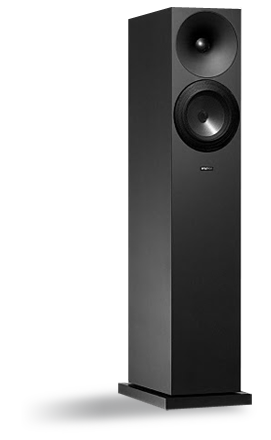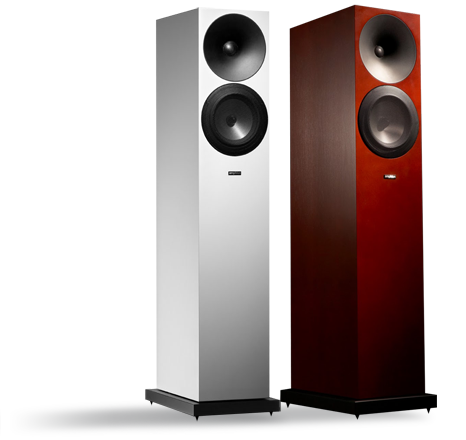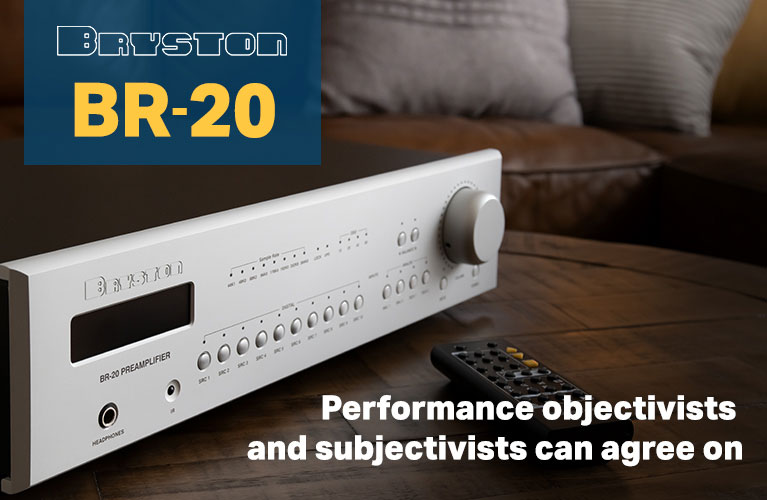Note: Measurements taken in the anechoic chamber at Canada's National Research Council can be found through this link.

 Last summer I reviewed the Argon3, a bookshelf speaker from the Finnish loudspeaker manufacturer Amphion. The speaker’s astounding transparency, powerful bass, and wonderful ability to faithfully communicate music in a way that never sounded analytical, all left a very positive impression on me. At the time, I wrote that they were best-sounding speakers I’d ever reviewed for the SoundStage! Network.
Last summer I reviewed the Argon3, a bookshelf speaker from the Finnish loudspeaker manufacturer Amphion. The speaker’s astounding transparency, powerful bass, and wonderful ability to faithfully communicate music in a way that never sounded analytical, all left a very positive impression on me. At the time, I wrote that they were best-sounding speakers I’d ever reviewed for the SoundStage! Network.
Just before Christmas, a pair of Amphion’s Argon3Ls were delivered. This floorstanding version of the Argon3 looks identical to its predecessor, except that its cabinet extends all the way to the floor. Based on my experience with the Argon3, my expectations for the Argon3L were high.
Description
When Amphion’s president, Anssi Hyvönen, wrote the design brief for the Argon3L, he thought his objective simple enough: Retain the sound of the Argon3, but add more bass with the help of a larger cabinet. He told me, however, that his "silly simple brief" proved more difficult to realize than he at first imagined. The design of the cabinet was perhaps the greatest challenge -- increasing the quantity of bass from a speaker while still retaining its quality of sound is no simple matter of putting the same drivers in a bigger box. Hyvönen told me that to get more low-end weight, they had to create a cleverly loaded bass enclosure that does double duty as passive subwoofer and speaker stand. It’s clear that the cabinet has thick walls and heavy internal bracing -- despite its medium-size dimensions (36.4"H x 7.5"W x 12"D), each Argon3L weighs 51 pounds. A quick rap on the walls with my knuckles returned a dull thud. Suffice it to say that the cabinet is solidly built.
A quick look at the Argon3L and its bookshelf sibling reveals that they have more than a little in common. The drive-units are identical: a 1" Integrator titanium-dome tweeter and a 6.5" aluminum midrange-woofer cone, both made by SEAS, of Norway, and in both models crossed over at 1600Hz -- though the Argon3L uses what Anssi Hyvönen describes as "in principle a second-order crossover with a major proprietary twist." Each driver is housed in a separate compartment in a manner nearly identical to that used in the Argon3, and the Argon3L uses the same high-quality, German-made WBT binding posts.
As with every Amphion speaker, the Argon3L’s most striking visual aspect is the deep, black waveguide in which the tweeter is recessed. Much has been written about the benefits of using waveguides; briefly, a waveguide helps to control the tweeter’s dispersion, for a smooth transition between its output and that of the midrange-woofer. It also increases the tweeter’s efficiency, which is why Amphion is able to set their crossover as low as 1600Hz -- which is below the 2-5kHz range, generally considered the most critical for human hearing. Finally, since the tweeter is recessed so far into the waveguide, its voice-coil is on the same vertical axis as the voice-coil of the driver below it. This means that the voice-coils of the two drivers -- i.e., their acoustic centers -- are roughly equidistant from the listener’s ears, thus ensuring good time-domain behavior from their outputs.

Amphion touts a technology called Uniformly Directive Diffusion (U/D/D), something the waveguide helps with. The goal of U/D/D is to make the speaker’s off- and on-axis frequency responses similar, with the highest frequencies gradually tapering off the farther the listener moves off the speaker’s central axis. Similar on- and off-axis frequency responses ensure that the reflected sound is similar in character to the direct sound heard at the listening seat, while also creating a wider sweet spot. Such speakers should be more forgiving of room placement.
The Argon3L’s frequency response is a claimed 30Hz–30kHz, ±3dB -- if accurate, an impressively wide bandwidth for a speaker with a tweeter and a single 6.5" driver. A sensitivity of 88dB and an impedance of 8 ohms would lead one to expect that the Argon3L could be driven easily by most amps, including tube amps. I had no problems getting all the volume I needed from a 100Wpc solid-state integrated amplifier.
The Argon3L is available for $3695 USD per pair in painted finishes of black, white, or full white (meaning the waveguide is also white), or for $3995/pair in birch, cherry, or walnut real-wood veneers. Each speaker comes with a black plinth of MDF that expands the speaker’s footprint and increases its stability while adding a nice visual accent. The Argon3L’s appearance is understatedly stunning. My fiancée and I adored its clean lines and simple look -- the very embodiment of minimalist design. But the Argon3L is not audio jewelry; if you like high-gloss cabinets and flashy metalwork, it’s not for you. The Amphions’ appearance will make them at home in a room with modern décor, where they’ll add beauty to the space without calling attention to themselves. And to prove that functionality needn’t preclude visual attractiveness, the tweeter has a small grille fixed permanently in place, and a second metal grille covers the midrange-woofer from prying fingers -- the drivers are protected while remaining visible. Although the woofer grilles didn’t detract from the speakers’ appearance, I did all of my listening with them removed.
Setup
On the rear of the Argon3L are two ports: one behind the midrange-woofer, the other nearer the bottom of the cabinet. Amphion supplies foam plugs to block the ports so the listener can tailor the sound to fit the room. I heard the best results with just the lower ports blocked. Although I was able to get a bit more bass without the plugs inserted, it was a bit too much for my room. When I mentioned to Hyvönen what I’d done, he indicated that this is how the plugs should be used. Apparently, the upper ports are there to allow the midrange to "breathe"; it’s best they be left open.
Sound
 As mentioned above, Amphion’s goal in designing the Argon3L was to add more bass while retaining the sound of the Argon3. As Anssi Hyvönen explained to me, a good minimonitor should open a clear window onto the music; too often, when a floorstanding version is built, it produces "upper-bass mush" that smears the window. With the Argon3L, Amphion has managed to keep that window as clear as crystal.
As mentioned above, Amphion’s goal in designing the Argon3L was to add more bass while retaining the sound of the Argon3. As Anssi Hyvönen explained to me, a good minimonitor should open a clear window onto the music; too often, when a floorstanding version is built, it produces "upper-bass mush" that smears the window. With the Argon3L, Amphion has managed to keep that window as clear as crystal.
Transparency was a hallmark of the Argon3’s sound, and the Argon3L has transparency in spades. If you want to hear deep into the recesses of your CDs, LPs, and digital files, the Argon3L will make that very easy for you. I suspect its stunning clarity is a function of its use of metal drivers as well as the sturdiness of its cabinet; whatever the reason, Amphion has hit the ball out of the park in this department.
As I played "In the Springtime of His Voodoo," from Tori Amos’s Boys for Pele (CD, eastwest A2 82862), the purity of her voice was astonishing. Amos’s recordings often have her voice mixed front and center, and through the Argon3Ls even her subtlest vocal nuances were on clear display. But it wasn’t just her voice that was so lucidly portrayed; the entire soundstage had this quality. Amos’s piano had a swagger that possessed a good sense of weight and scale and, much like her voice, sounded as if it were in the room with me. The thump of the bass was warm and clear, and contributed to the voluminous stage revealed by the Argon3Ls. The whole effect was impressive, to say the least.
In fact, the Argon3Ls’ soundstage was so incredibly precise that I hardly had to close my eyes to sort out everything happening on it. Images were carved out so well in space, and the musical whole was so utterly coherent, that I could easily sort out the sonic picture in even complex musical passages. Instruments, voices, sound effects, etc. -- each occupied a distinct position in a way that brought the music to life. Creating the illusion that the music is unfolding as if it were actually happening in front of you is no easy task, but the Argon3L handled it better than any other speaker I’ve reviewed. In this regard, the Argon3 bookshelf model was very similar, but the floorstander’s added sense of scale made the reproduction of some recordings even more convincing.
Perhaps not surprisingly, this was especially true with classical music. The wide dynamic range and expansive soundstage of the Non allegro, from Rachmaninoff’s Symphonic Dances (CD, Reference RR-96CD), were ably demonstrated. In this well-recorded performance, the Minnesota Orchestra, under the baton of Eiji Oue, was spread across a broad, deep stage that had such a convincing sense of height that it was about as close to experiencing the real thing as I could hope to hear in the comfort of my room. Through the Argon3Ls the music was so open and clear that each section of the orchestra was delineated with ease. Non allegro feels almost a bit manic -- slow in some passages, explosive in others. The dynamic range of this recording was very well served by the Amphions; everything, from the most earth-rattling crescendos to the lowest-level details, was convincingly conveyed. Obviously, larger speakers would offer an even greater sense of scale, but I suspect the Argon3Ls would meet the requirements of most listeners with rooms of medium size.
Much of this sense of scale had to do with the fact that the Argon3L could play ridiculously loud when asked to while showing no sign of strain. As with any speaker, there was a point where the Argon3L cried uncle, but it would have to be pushed to unsafe listening levels, or used in a room far too big for it, before it reached that point. Amphion recommends 30-150Wpc to power the Argon3Ls; clearly, they’re built to handle it. At one point, while playing some bass-heavy trip-hop, the midrange-woofers were springing back and forth -- but the sound remained composed, the speakers unfazed. I quickly got over my worry that I was about to damage them.
With the Argon3L, Amphion has met its goal of maintaining the clarity in the mids and highs achieved by the Argon3 while providing additional bass response. The first thing I’d noticed when reviewing the Argon3 was how abundant its low end was; with the Argon3L, this aspect of performance was taken to another level -- a lower one, I suppose. When I played them for the first time, the sheer quantity of low-frequency energy made my jaw drop. Listening to Big Boi’s Sir Lucious Left Foot: The Son of Chico Dusty (CD, Def Jam B001437702), I was a bit floored by the voluminous bass filling the room.
The Argon3L produced bass of such clarity and detail that, even though the bass tended to have a lot of energy down low, it never sounded bloated or sloppy. This helped to expand the scale of the music while lending some venues a greater sense of space. The soundstage would often have a touch more depth, and often the music seemed to extend beyond the front wall of my listening room.
The Argon3Ls did explosive justice to well-made pop recordings like the Big Boi disc, which features very deep, unapologetically fat bass lines that can really bloom out into the room. The Amphions delivered deep, powerful bass that remained clean and didn’t cloud the midrange. The same was true of the synthesized bass on another pop recording, The xx’s self-titled debut (CD, Young Turks YT031). In "Fantasy," the bass had plenty of thump -- its rhythm was like a heartbeat enveloping the entire room, flooding it and immersing me in sound.
Comparison
I didn’t have another pair of floorstanders around to compare with the Amphions, but I did have my longtime reference, PSB’s Platinum M2 ($2000/pair when available). The M2 is a hefty bookshelf speaker with the same driver configuration as the Argon3L: a 1" aluminum tweeter and a 6.5" fiberglass midrange-woofer. However, the similarities sort of end there. The M2 has a fourth-order crossover, and its tweeter is not mounted in a waveguide. Furthermore, the M2’s cabinet is a combination of MDF and aluminum, with a front port rather than rear ports.
There are some sonic similarities, but far more differences. The Platinum M2 and the Amphion Argon3L both sound pretty neutral; neither speaker imposes any obvious coloration on the sound, instead allowing the music to speak for itself. Although this means that some of the poorly recorded music I own sounded awful through either model, it also meant that the well-recorded stuff sounded brilliant, in some instances as if it were happening right in front of me.
Transparency is where the sounds of these speakers began to diverge. The M2 sounds very clean; when I bought the pair of them, I didn’t imagine things could get much better. I was wrong. The Argon3L sounded more detailed, and was able to communicate even more information about the space around instruments and the venue in which the music was made. The leading edges of notes, as well as their decays, were captured with a breathtaking clarity that contributed enormously to making the music come alive.
With regard to bass weight and depth, the Argon3L won hands down. Not only was its bass every bit as clear and detailed as the M2’s, there was just more of it. Of course, this was to be expected, given the Argon3L’s much larger cabinet, but I’m still amazed by how much low-end weight and authority Amphion has been able to extract from this speaker. The PSB Platinum M2 sounds bigger than it looks, but it couldn’t match the volume of air moved by the Argon3L.
Conclusions
If I were allowed only three words to summarize the performance of the Amphion Argon3L, they would be pure, powerful, and precise. I have not heard another speaker as beautifully integrated, as wonderfully coherent, or as close to full-range as this. For my tastes, the Argon3L performed a near-perfect balancing act: it sounded astonishingly clean and faithful to the signals fed it, while remaining musical and capable of holding my attention for long periods of time. Add to this its ability to produce sufficient low-end weight to give music a real firm underpinning, and an appearance that has earned it the title "best-looking speaker I’ve had in my listening room," and I think the Argon3L makes a strong case for being a complete speaker. At just under $4000/pair it isn’t cheap, but I’ve heard more expensive speakers that don’t sound nearly as good. While there’s no such thing as a perfect speaker, Amphion’s Argon3L comes as close as I’ve heard to reaching that elusive ideal.
. . . Phillip Beaudette
philipb@soundstagenetwork.com
Associated Equipment
- Speakers -- Amphion Argon3, PSB Platinum M2
- Integrated amplifier -- Bryston B100 SST
- Sources -- NAD C542 CD player, Thorens TD-160HD turntable, Rega RB250 tonearm, Dynavector DV-10X5 high-output moving-coil cartridge
- Speaker cables -- AudioQuest Type 4
- Interconnects -- AudioQuest Copperhead, AMX Optimum AVC 31 coaxial
- Power conditioner -- ExactPower EP15A
Amphion Argon3L Loudspeakers
Price: $3695 USD per pair in black, white, or full white painted finish; $3995/pair in birch, cherry, or walnut real-wood veneers.
Warranty: Five years parts and labor.
Amphion Loudspeakers Ltd.
P.O. Box 6
70821
Kuopio, Finland
Phone: +358 17-2882-100
Fax: +358 17-2882-111
E-mail: info@amphion.fi
Website: www.amphion.fi
Canadian distributor:
VMAX Services
CP 8, 1217 Greene Ave.
Montreal, QC H3Z 2T1
Phone: (514) 931-1880
Fax : (514) 931-8891
E-mail: info@vmax-services.com
US distributor:
VMAX Services
P.O. Box 570
Chazy, NY 12921
Phone: 1-800-771-8279 (toll-free) or (514) 932-7786
Fax: (514) 931-8891
E-mail: info@vmax-services.com






















